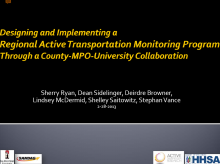We are pleased to announce an exciting new alliance between Active Living Research and GP RED to co-host and coordinate...
Designing and Implementing a Regional Active Transportation Monitoring Program through a County-MPO-University Collaboration

Presentation at the 2013 Active Living Research Annual Conference.
Background and Purpose
This paper describes one region’s efforts to link active transportation performance monitoring to regional transportation planning by establishing a network of automated bicycle and pedestrian count stations along the proposed regional bicycle network, which was recently adopted in the San Diego Association of Governments (SANDAG) 2050 Regional Transportation Plan. The implementation of this counting program grew out of a collaboration between the County of San Diego Health and Human Services Agency (HHSA), San Diego State University (SDSU) public health and city planning researchers, and active transportation planning professionals at SANDAG. The multi-dimensional, multi-disciplinary effort created a foundation for methodological rigor through the academic input, strong funding availability through a county grant provided by the Center for Disease Control and Prevention (Communites Putting Prevention to Work), and main-streaming planning and programing through SANDAG’s support.
Description
The count station siting methodology employed a multi-step process where the regional bicycle network was segmented, and then stratified sampling employed to select a subset of bicycle network segments where counters would be installed. The siting methodology first established a comprehensive network of count stations representing ultimate coverage of the regional bicycle network (170 count stations). Then a subset of representative locations was selected for phase one count program implementation (35 counts stations). to date, count equipment has been installed at 17 locations and the remainder is expected to be installed by September 2012. When fully implemented, this counting program will be one of the most comprehensive automated data collection systems of any region in the US. Through extensive technology research, the team determined that Eco-Counter offered optimal bicycle and pedestrian count technology based upon two key criteria: 1) automated upload and transfer of the count data to a web-based server which precludes the need to conduct field data uploads, and 2) capability to count on-street cyclists and distinguish them from automobiles. The equipment records counts at 15- minute intervals and the data is uploaded daily via modem to a web-based server. The siting methodology was vetted with SANDAG and County staff, as well as SANDAG’s Bicycle and Pedestrian Working Group consisting of representatives from local advocacy groups, the 18 local jurisdictions, and Caltrans. The final siting criteria focused on four key features: 1) siting to occur along the existing or planned regional bicycle network as presented in the San Diego Regional Bicycle Plan and the Regional Transportation Plan (RTP), 2) siting to occur within Smart Growth Opportunity Areas (SGOA), representing locations where new growth will be focused in mixed use, high density infill development consistent with SANDAG’s Regional Comprehensive Plan (RCP), 3) comprehensive coverage of the region, and 4) siting to occur in a manner that is representative of the region’s distribution of population density, employment density, and median household income (stratified sampling).
Lessons Learned
The hope for this program is that on-going funding is secured in order to maintain the currently installed equipment, and to expand the system to include all of the proposed 170 count stations. SDSU faculty are working with SANDAG staff to draft a memorandum of understanding that will allocate funding to the university to support maintenance and expansion of the program. The data will support trend analysis, before-after analysis, and overall monitoring of active travel impacts resulting from implementation of SANDAG’s regional bicycle network and SGOA land development projects.
Conclusions and Implications
The design and implementation of this regional active transportation program reflects the tremendous synergy and positive outcome that can be achieved when public health professionals, planning professionals, and academic researchers collaborate to enhance our understanding of active travel. The multi-disciplinary approach was necessary to spearhead innovation that would be strongly grounded in on-going regional programs.
Next Steps
To date, several of the automated count equipment units have been installed. The data can be accessed at Eco-Counters website via their software called Eco-Visio. A training for SANDAG and HHSA staff was conducted in March 2012 to introduce key team members to the Eco-Visio software and to view some of the preliminary data being collected by the count equipment. San Diego State University staff are also working to establish a research center that will serve as a data clearinghouse for the bicycle and pedestrian count data. The proposed research center will work with SANDAG staff to disseminate bicycle and pedestrian count data to jurisdictions for planning purposes, as well as to support consideration of bicycle and pedestrian users in all planning and design efforts.
Support / Funding Source
This project was made possible by funding from the Centers for Disease Control and Prevention, through the County of San Diego.
- DOWNLOAD "2013_Methods_Ryan.pdf" PDF (8.32 MB) Presentations
STAY UP TO DATE
RECENTLY ADDED TOOLS & RESOURCES
MOVE! A BLOG ABOUT ACTIVE LIVING
The "Active Living Conference" aims to break down research and practice silos and...







